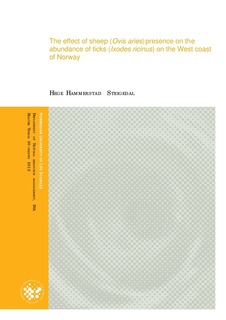| dc.contributor.author | Steigedal, Hege Hammerstad | |
| dc.date.accessioned | 2012-08-06T10:25:28Z | |
| dc.date.available | 2012-08-06T10:25:28Z | |
| dc.date.copyright | 2012 | |
| dc.date.issued | 2012-08-06 | |
| dc.identifier.uri | http://hdl.handle.net/11250/186676 | |
| dc.description.abstract | The prevalence of ticks is increasing in many parts of the world, including Norway. There are uncertainties why this is happening, but the suggested main three drivers are climate, encroachment and increased abundance of vertebrate hosts. In this thesis I investigate the variation in abundance of ticks in four areas in Møre and Romsdal, Norway, and relate this specifically to the presence of sheep (Ovis aries). The cloth-lure method was used to collect ticks on transects with known previous presence of sheep and compared with control transects with no sheep. In this thesis I test the following two hypotheses; The increased host hypothesis (H1) predicts that since tick reproduction is facilitated by the presence of larger mammals tick abundance will be higher in sheep areas than in control areas. The alternative hypothesis, the reduced encroachment hypothesis (H2), predicts that sheep keep vegetation low and therefore reduce tick survival. Consistent with the reduced encroachment hypothesis H2 I found that tick abundance was higher in control areas than in areas with sheep. There was a seasonal variation in tick density. The tick abundance peaked in summer in both sheep and control areas. The main management implication of my thesis is that sheep grazing effects are an efficient tool to reduce vegetation height and shrub encroachment which reduce tick abundance. | no_NO |
| dc.language.iso | eng | no_NO |
| dc.publisher | Norwegian University of Life Sciences, Ås | |
| dc.title | The effect of sheep (Ovis aries) on the abundance of ticks (Ixodes ricinus) on the West coast of Norway | no_NO |
| dc.type | Master thesis | no_NO |
| dc.subject.nsi | VDP::Agriculture and fishery disciplines: 900::Agriculture disciplines: 910::Management of natural resources: 914 | no_NO |
| dc.subject.nsi | VDP::Mathematics and natural science: 400::Zoology and botany: 480::Parasitology: 484 | no_NO |
| dc.source.pagenumber | 28 | no_NO |
